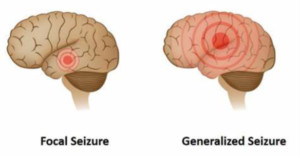 Different Types of Focal Onset Seizures
Different Types of Focal Onset Seizures
A focal onset seizure begins in one side of the brain, and it is the most common type of seizure experienced by people with epilepsy. They were previously called partial seizures. The term “focal” is now used instead of partial to be more accurate when talking about where seizures begin. Focal onset seizures are broken down into two groups by how aware a person is of their surroundings.
-
- Focal Onset Aware Seizures: When a person is awake and aware during a seizure, it’s called a focal aware seizure. This used to be called a simple partial seizure.
- Focal Onset Impaired Awareness: When a person is confused or their awareness is affected in some way during a focal seizure, it’s called a focal impaired awareness seizure. This used to be called a complex partial seizure.
During a focal onset aware seizure, the person is conscious and aware of their surroundings. This used to be called a “simple partial” seizure. A person experiencing a focal onset aware seizure is awake and alert. While they may not be able to talk during the seizure, they can recall what was going on during their seizure. They may experience some involuntary movements and feelings called “automatisms.” This can be jerking arms or legs, a change in smell or taste, dizziness, or even flashing lights. These seizures usually last less than 2 minutes.
Focal aware seizures can happen to anyone. People who have had a head injury, brain infection, stroke, or brain tumor are more likely to experience them. However, like many other seizures, there may not be a known cause.
During a focal onset impaired awareness seizure, the person is not fully aware of their surroundings. This used to be called a “complex partial” seizure or even “psychomotor” seizure. These seizures typically start in the temporal lobe or frontal lobe of the brain and can last between 30 seconds and 3 minutes.
A person experiencing a focal impaired awareness seizure may look like they are daydreaming or staring into space. They may be only partially or completely unaware of their surroundings. Any change in consciousness means that it is a focal impaired awareness seizure. During this time, they may freeze or show repetitive movements such as chewing, hand rubbing, repeating words, or even walking in circles.
Sometimes, a focal onset impaired awareness seizure begins with a focal onset aware seizure. In this case, the focal aware seizure is commonly called an “aura.” On the other hand, a focal impaired awareness seizure can sometimes spread to both sides of the brain and become a focal to bilateral tonic-clonic seizure.
When a focal onset seizure spreads to both sides of the brain, it is called a focal to bilateral tonic-clonic seizure. This is different from a generalized onset tonic-clonic seizure, which starts on both sides of the brain rather than just one. These seizures typically last 2-3 minutes and are more likely to happen to people who already have focal onset seizures.
- The focal onset seizure comes first. Symptoms will vary depending on whether they experience focal aware or focal impaired awareness seizures.
- The tonic phase comes next.
- All the muscles stiffen.
- Air being forced past the vocal cords causes a cry or groan.
- The person loses consciousness and falls to the floor.
- A person may bite their tongue or inside of their cheek. If this happens, saliva may look a bit bloody.
- After the tonic phase comes the clonic phase.
- The arms and legs begin to jerk rapidly and rhythmically, bending and relaxing at the elbows, hips, and knees.
- After a few minutes, the jerking slows and stops.
It may be hard to tell if a tonic-clonic seizure starts as focal or generalized onset, especially if they happen during sleep or are not seen by anyone else. These are called unknown onset tonic-clonic seizures.
Some people with epilepsy use the word “aura” to describe the feeling they get that warns them they’re about to have a seizure. An aura is actually a focal aware seizure starting in one side of the brain. The seizure then spreads to affect both sides of the brain, becoming a generalized seizure. Some people who have focal aware seizures on their own also call them auras.
For example, the seizure may start with a smell, feeling of nausea, or change in sensation or movement. The eyes or head may turn forcefully to one side. The person is fully aware of what’s happening at this point.




